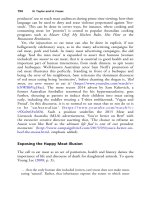The palgrave international handbook of a 458
Bạn đang xem bản rút gọn của tài liệu. Xem và tải ngay bản đầy đủ của tài liệu tại đây (25.9 KB, 1 trang )
460
R. Sollund
Welfare Act which was revised in 2009.9 According to paragraph 1 of the Act, it
is forbidden to import, sell, buy, give away, receive, or keep as domestic animals,
companion animals, or otherwise in captivity alien (exotic) mammals, reptiles,
toads, frogs, or salamanders. Therefore, reptiles are not openly for sale in
Norway, whether on Norwegian Internet sites, at reptile fora or in other ways.
The legality of owning reptiles in Sweden and Denmark makes it possible for
Norwegian reptile enthusiasts to buy a reptile in zoo shops there and traffic the
animals to Norway (Sollund 2013a). Because Norway shares a long and porous
border with Sweden and also borders Finland and Russia in the north, trafficking
animals to Norway from these countries is fairly easy (Sollund 2013a), especially
given the focus of Norwegian Customs is on drugs rather than on CITES,
according to interview data (See also Runhovde 2015). For example; Customs
have seizure targets for drugs but not for CITES which entail drugs are prioritized.
Consequently, they concentrate on detecting drugs, e.g., when they search parcels
sent to Norwegian from other countries, rather than animals or animal products.
When it comes to parrots, however, the situation is quite different. Parrots,
although exotic, can be obtained relatively cheaply and easily on the website
Finn.no. There is, in effect, no requirement in Norway that parrots for sale are
not wild caught because there is no demand that owners document where
their birds came from, birds must not be id chipped which could facilitate
tracing their origin. Often on Finn.no, owners sell their birds after only
owning them a short while (one to two years), indicating that parrots are
often bought on impulse by people who are unaware of the demands of a
parrot and the challenges involved in keeping one, for example, droppings,
noise, difficult behavior (birds are often sold when they reach puberty at age 3
or 4 when they, like human teenagers, can be harder to handle). Even though
there is no ban against possessing or selling parrots, it is, nonetheless, illegal to
bring them to Norway without permission from the Norwegian Environment
Agency which extends an import permit if CITES regulations are followed,
that is, if the trafficker has an export permit from the state the bird is taken (all
parrots are CITES listed).10 The fact that breeding parrots and selling them is
legal in Norway, however, puts caught wild birds in danger. Breeders often
need fresh genes, and this need will continue to drive the wildlife trade despite
claims of breeding facilities for wildlife, including zoos, that they are run in
order to preserve species (Rodríguez and García 2008; Busch et al. 2014). In
Norway, my data include several verdicts concerning bird traffickers who also
9
/> />
10









